Comprehensive Report: Conflict Management in Organizations
VerifiedAdded on 2020/03/16
|7
|1715
|229
Report
AI Summary
This report delves into the critical role of conflict management within organizations, examining the causes, effects, and various resolution strategies. It begins by outlining the background of conflict, highlighting its pervasive nature in modern business environments and the significant time and resources organizations invest in addressing it. The report identifies various sources of conflict, including interpersonal disagreements, interdepartmental rivalries, and differing management styles. It explores the different forms of conflict, such as intrapersonal, intergroup, and intragroup conflicts, and their impact on employee morale, teamwork, and overall productivity. Furthermore, the report analyzes the negative consequences of conflict, such as decreased employee performance, wasted resources, and erosion of trust. However, it also acknowledges the potential positive aspects of conflict, such as fostering creativity and driving change. The report then explores several conflict resolution mechanisms, including joint consultation, collective bargaining, and the involvement of third-party mediators. Finally, it examines the impact of effective conflict management on employee performance, emphasizing the importance of creating a harmonious and productive work environment. This report provides a comprehensive overview of conflict management, offering valuable insights for organizations seeking to improve their operational efficiency and employee relations.
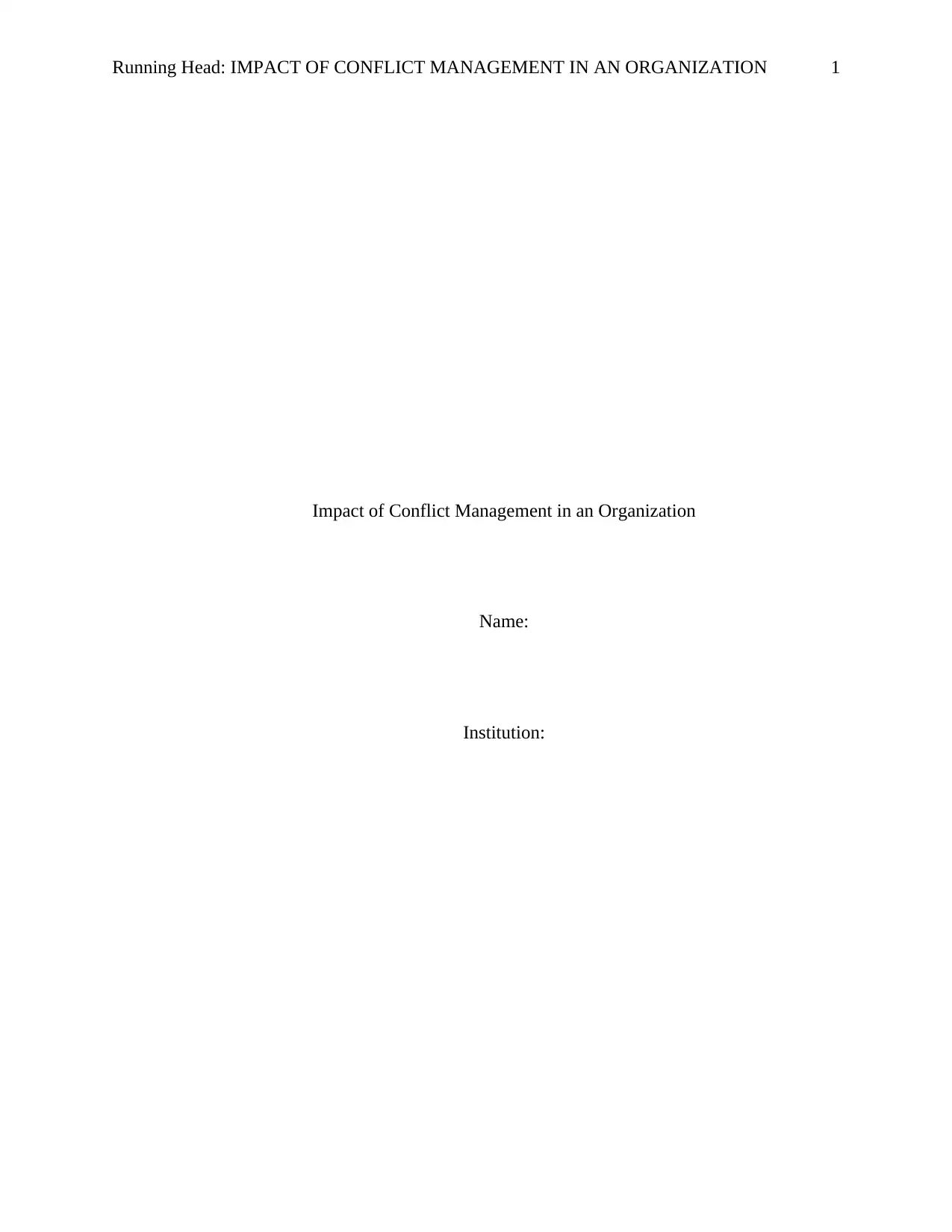
Running Head: IMPACT OF CONFLICT MANAGEMENT IN AN ORGANIZATION 1
Impact of Conflict Management in an Organization
Name:
Institution:
Impact of Conflict Management in an Organization
Name:
Institution:
Paraphrase This Document
Need a fresh take? Get an instant paraphrase of this document with our AI Paraphraser
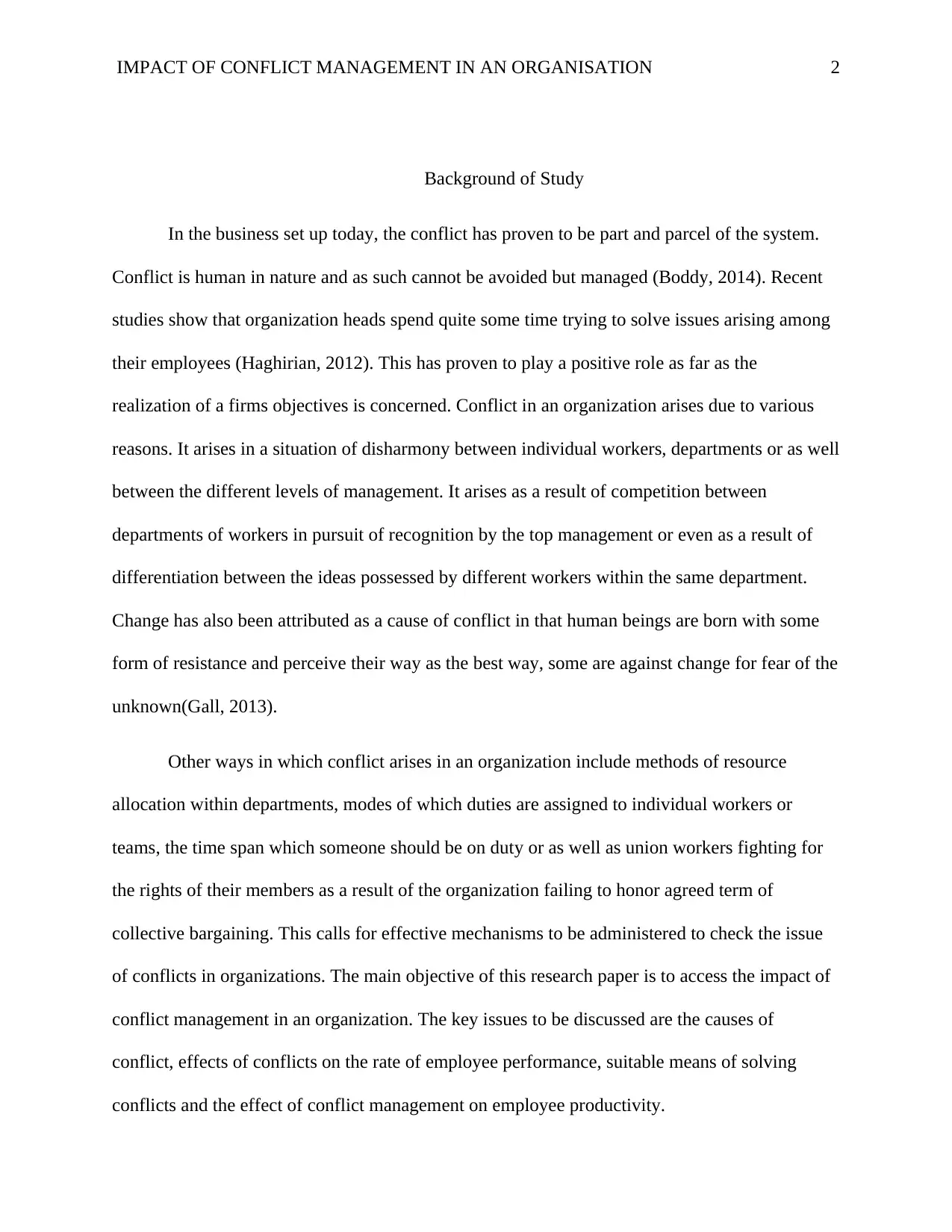
IMPACT OF CONFLICT MANAGEMENT IN AN ORGANISATION 2
Background of Study
In the business set up today, the conflict has proven to be part and parcel of the system.
Conflict is human in nature and as such cannot be avoided but managed (Boddy, 2014). Recent
studies show that organization heads spend quite some time trying to solve issues arising among
their employees (Haghirian, 2012). This has proven to play a positive role as far as the
realization of a firms objectives is concerned. Conflict in an organization arises due to various
reasons. It arises in a situation of disharmony between individual workers, departments or as well
between the different levels of management. It arises as a result of competition between
departments of workers in pursuit of recognition by the top management or even as a result of
differentiation between the ideas possessed by different workers within the same department.
Change has also been attributed as a cause of conflict in that human beings are born with some
form of resistance and perceive their way as the best way, some are against change for fear of the
unknown(Gall, 2013).
Other ways in which conflict arises in an organization include methods of resource
allocation within departments, modes of which duties are assigned to individual workers or
teams, the time span which someone should be on duty or as well as union workers fighting for
the rights of their members as a result of the organization failing to honor agreed term of
collective bargaining. This calls for effective mechanisms to be administered to check the issue
of conflicts in organizations. The main objective of this research paper is to access the impact of
conflict management in an organization. The key issues to be discussed are the causes of
conflict, effects of conflicts on the rate of employee performance, suitable means of solving
conflicts and the effect of conflict management on employee productivity.
Background of Study
In the business set up today, the conflict has proven to be part and parcel of the system.
Conflict is human in nature and as such cannot be avoided but managed (Boddy, 2014). Recent
studies show that organization heads spend quite some time trying to solve issues arising among
their employees (Haghirian, 2012). This has proven to play a positive role as far as the
realization of a firms objectives is concerned. Conflict in an organization arises due to various
reasons. It arises in a situation of disharmony between individual workers, departments or as well
between the different levels of management. It arises as a result of competition between
departments of workers in pursuit of recognition by the top management or even as a result of
differentiation between the ideas possessed by different workers within the same department.
Change has also been attributed as a cause of conflict in that human beings are born with some
form of resistance and perceive their way as the best way, some are against change for fear of the
unknown(Gall, 2013).
Other ways in which conflict arises in an organization include methods of resource
allocation within departments, modes of which duties are assigned to individual workers or
teams, the time span which someone should be on duty or as well as union workers fighting for
the rights of their members as a result of the organization failing to honor agreed term of
collective bargaining. This calls for effective mechanisms to be administered to check the issue
of conflicts in organizations. The main objective of this research paper is to access the impact of
conflict management in an organization. The key issues to be discussed are the causes of
conflict, effects of conflicts on the rate of employee performance, suitable means of solving
conflicts and the effect of conflict management on employee productivity.
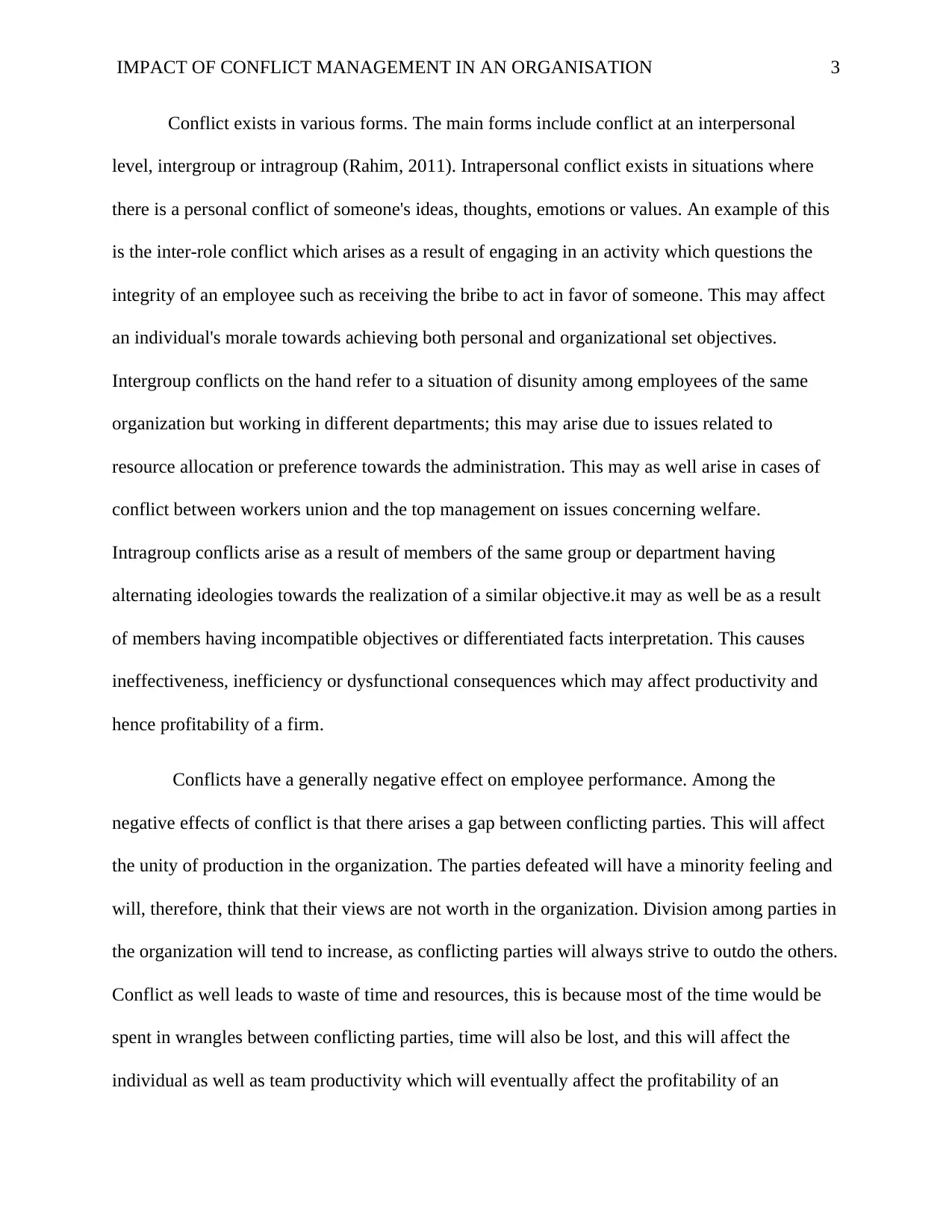
IMPACT OF CONFLICT MANAGEMENT IN AN ORGANISATION 3
Conflict exists in various forms. The main forms include conflict at an interpersonal
level, intergroup or intragroup (Rahim, 2011). Intrapersonal conflict exists in situations where
there is a personal conflict of someone's ideas, thoughts, emotions or values. An example of this
is the inter-role conflict which arises as a result of engaging in an activity which questions the
integrity of an employee such as receiving the bribe to act in favor of someone. This may affect
an individual's morale towards achieving both personal and organizational set objectives.
Intergroup conflicts on the hand refer to a situation of disunity among employees of the same
organization but working in different departments; this may arise due to issues related to
resource allocation or preference towards the administration. This may as well arise in cases of
conflict between workers union and the top management on issues concerning welfare.
Intragroup conflicts arise as a result of members of the same group or department having
alternating ideologies towards the realization of a similar objective.it may as well be as a result
of members having incompatible objectives or differentiated facts interpretation. This causes
ineffectiveness, inefficiency or dysfunctional consequences which may affect productivity and
hence profitability of a firm.
Conflicts have a generally negative effect on employee performance. Among the
negative effects of conflict is that there arises a gap between conflicting parties. This will affect
the unity of production in the organization. The parties defeated will have a minority feeling and
will, therefore, think that their views are not worth in the organization. Division among parties in
the organization will tend to increase, as conflicting parties will always strive to outdo the others.
Conflict as well leads to waste of time and resources, this is because most of the time would be
spent in wrangles between conflicting parties, time will also be lost, and this will affect the
individual as well as team productivity which will eventually affect the profitability of an
Conflict exists in various forms. The main forms include conflict at an interpersonal
level, intergroup or intragroup (Rahim, 2011). Intrapersonal conflict exists in situations where
there is a personal conflict of someone's ideas, thoughts, emotions or values. An example of this
is the inter-role conflict which arises as a result of engaging in an activity which questions the
integrity of an employee such as receiving the bribe to act in favor of someone. This may affect
an individual's morale towards achieving both personal and organizational set objectives.
Intergroup conflicts on the hand refer to a situation of disunity among employees of the same
organization but working in different departments; this may arise due to issues related to
resource allocation or preference towards the administration. This may as well arise in cases of
conflict between workers union and the top management on issues concerning welfare.
Intragroup conflicts arise as a result of members of the same group or department having
alternating ideologies towards the realization of a similar objective.it may as well be as a result
of members having incompatible objectives or differentiated facts interpretation. This causes
ineffectiveness, inefficiency or dysfunctional consequences which may affect productivity and
hence profitability of a firm.
Conflicts have a generally negative effect on employee performance. Among the
negative effects of conflict is that there arises a gap between conflicting parties. This will affect
the unity of production in the organization. The parties defeated will have a minority feeling and
will, therefore, think that their views are not worth in the organization. Division among parties in
the organization will tend to increase, as conflicting parties will always strive to outdo the others.
Conflict as well leads to waste of time and resources, this is because most of the time would be
spent in wrangles between conflicting parties, time will also be lost, and this will affect the
individual as well as team productivity which will eventually affect the profitability of an
⊘ This is a preview!⊘
Do you want full access?
Subscribe today to unlock all pages.

Trusted by 1+ million students worldwide
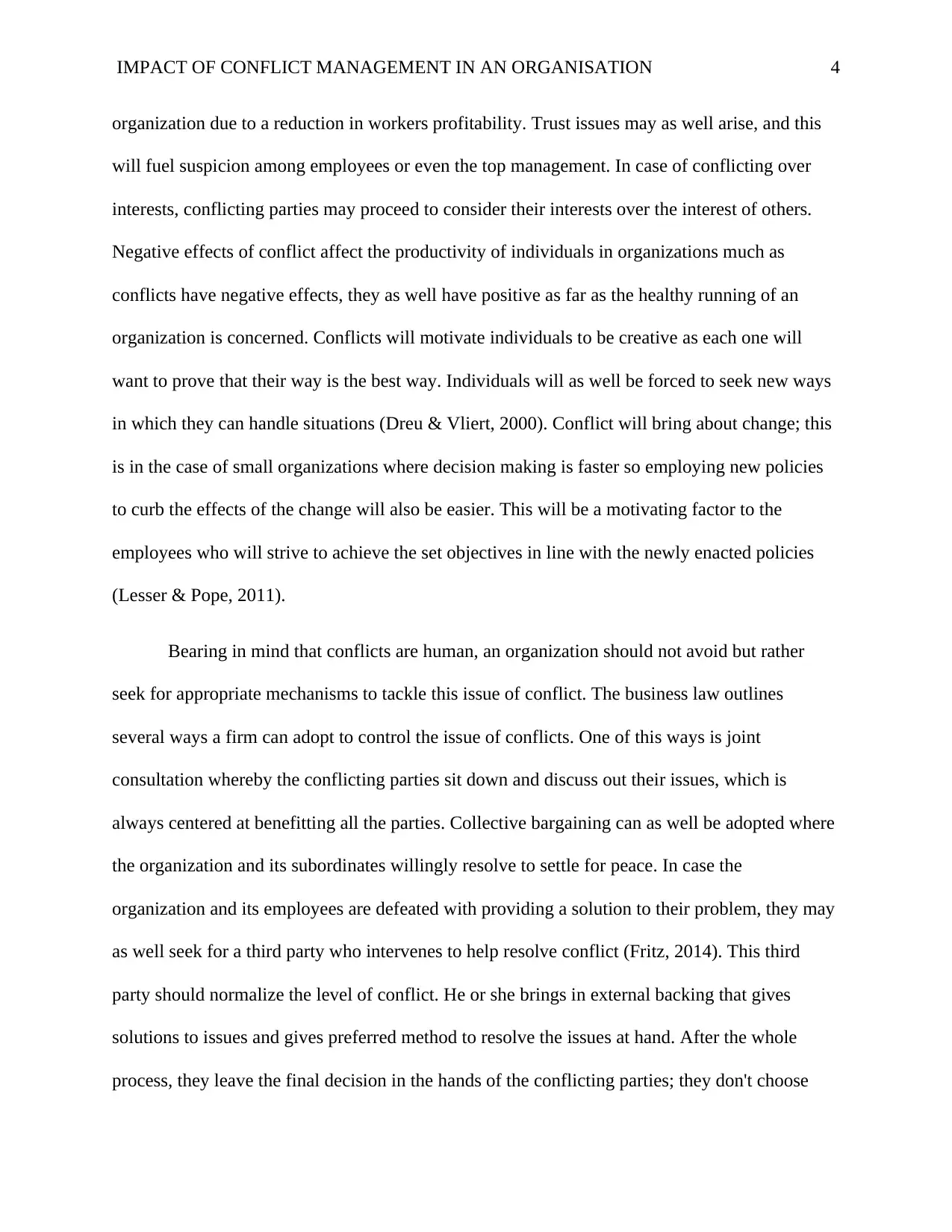
IMPACT OF CONFLICT MANAGEMENT IN AN ORGANISATION 4
organization due to a reduction in workers profitability. Trust issues may as well arise, and this
will fuel suspicion among employees or even the top management. In case of conflicting over
interests, conflicting parties may proceed to consider their interests over the interest of others.
Negative effects of conflict affect the productivity of individuals in organizations much as
conflicts have negative effects, they as well have positive as far as the healthy running of an
organization is concerned. Conflicts will motivate individuals to be creative as each one will
want to prove that their way is the best way. Individuals will as well be forced to seek new ways
in which they can handle situations (Dreu & Vliert, 2000). Conflict will bring about change; this
is in the case of small organizations where decision making is faster so employing new policies
to curb the effects of the change will also be easier. This will be a motivating factor to the
employees who will strive to achieve the set objectives in line with the newly enacted policies
(Lesser & Pope, 2011).
Bearing in mind that conflicts are human, an organization should not avoid but rather
seek for appropriate mechanisms to tackle this issue of conflict. The business law outlines
several ways a firm can adopt to control the issue of conflicts. One of this ways is joint
consultation whereby the conflicting parties sit down and discuss out their issues, which is
always centered at benefitting all the parties. Collective bargaining can as well be adopted where
the organization and its subordinates willingly resolve to settle for peace. In case the
organization and its employees are defeated with providing a solution to their problem, they may
as well seek for a third party who intervenes to help resolve conflict (Fritz, 2014). This third
party should normalize the level of conflict. He or she brings in external backing that gives
solutions to issues and gives preferred method to resolve the issues at hand. After the whole
process, they leave the final decision in the hands of the conflicting parties; they don't choose
organization due to a reduction in workers profitability. Trust issues may as well arise, and this
will fuel suspicion among employees or even the top management. In case of conflicting over
interests, conflicting parties may proceed to consider their interests over the interest of others.
Negative effects of conflict affect the productivity of individuals in organizations much as
conflicts have negative effects, they as well have positive as far as the healthy running of an
organization is concerned. Conflicts will motivate individuals to be creative as each one will
want to prove that their way is the best way. Individuals will as well be forced to seek new ways
in which they can handle situations (Dreu & Vliert, 2000). Conflict will bring about change; this
is in the case of small organizations where decision making is faster so employing new policies
to curb the effects of the change will also be easier. This will be a motivating factor to the
employees who will strive to achieve the set objectives in line with the newly enacted policies
(Lesser & Pope, 2011).
Bearing in mind that conflicts are human, an organization should not avoid but rather
seek for appropriate mechanisms to tackle this issue of conflict. The business law outlines
several ways a firm can adopt to control the issue of conflicts. One of this ways is joint
consultation whereby the conflicting parties sit down and discuss out their issues, which is
always centered at benefitting all the parties. Collective bargaining can as well be adopted where
the organization and its subordinates willingly resolve to settle for peace. In case the
organization and its employees are defeated with providing a solution to their problem, they may
as well seek for a third party who intervenes to help resolve conflict (Fritz, 2014). This third
party should normalize the level of conflict. He or she brings in external backing that gives
solutions to issues and gives preferred method to resolve the issues at hand. After the whole
process, they leave the final decision in the hands of the conflicting parties; they don't choose
Paraphrase This Document
Need a fresh take? Get an instant paraphrase of this document with our AI Paraphraser
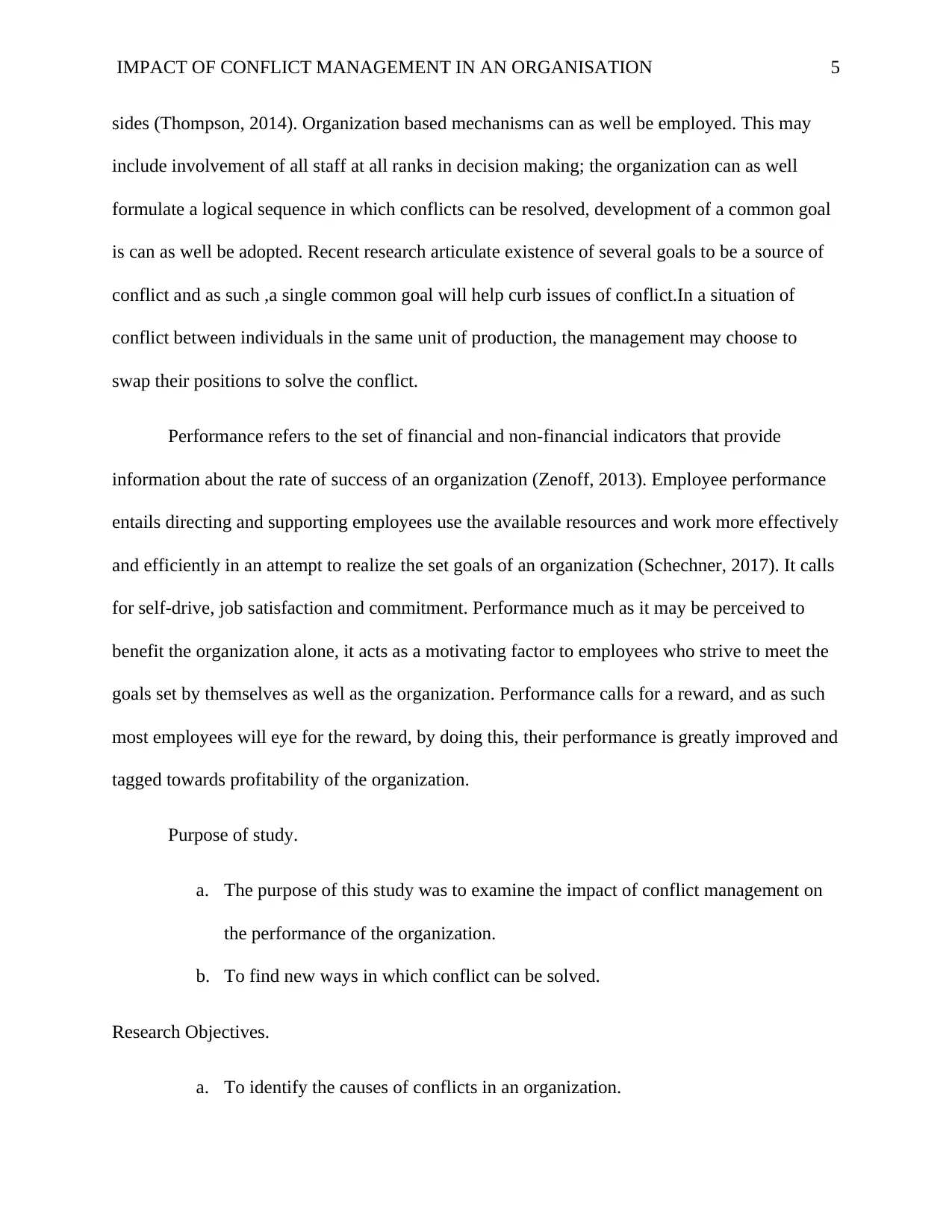
IMPACT OF CONFLICT MANAGEMENT IN AN ORGANISATION 5
sides (Thompson, 2014). Organization based mechanisms can as well be employed. This may
include involvement of all staff at all ranks in decision making; the organization can as well
formulate a logical sequence in which conflicts can be resolved, development of a common goal
is can as well be adopted. Recent research articulate existence of several goals to be a source of
conflict and as such ,a single common goal will help curb issues of conflict.In a situation of
conflict between individuals in the same unit of production, the management may choose to
swap their positions to solve the conflict.
Performance refers to the set of financial and non-financial indicators that provide
information about the rate of success of an organization (Zenoff, 2013). Employee performance
entails directing and supporting employees use the available resources and work more effectively
and efficiently in an attempt to realize the set goals of an organization (Schechner, 2017). It calls
for self-drive, job satisfaction and commitment. Performance much as it may be perceived to
benefit the organization alone, it acts as a motivating factor to employees who strive to meet the
goals set by themselves as well as the organization. Performance calls for a reward, and as such
most employees will eye for the reward, by doing this, their performance is greatly improved and
tagged towards profitability of the organization.
Purpose of study.
a. The purpose of this study was to examine the impact of conflict management on
the performance of the organization.
b. To find new ways in which conflict can be solved.
Research Objectives.
a. To identify the causes of conflicts in an organization.
sides (Thompson, 2014). Organization based mechanisms can as well be employed. This may
include involvement of all staff at all ranks in decision making; the organization can as well
formulate a logical sequence in which conflicts can be resolved, development of a common goal
is can as well be adopted. Recent research articulate existence of several goals to be a source of
conflict and as such ,a single common goal will help curb issues of conflict.In a situation of
conflict between individuals in the same unit of production, the management may choose to
swap their positions to solve the conflict.
Performance refers to the set of financial and non-financial indicators that provide
information about the rate of success of an organization (Zenoff, 2013). Employee performance
entails directing and supporting employees use the available resources and work more effectively
and efficiently in an attempt to realize the set goals of an organization (Schechner, 2017). It calls
for self-drive, job satisfaction and commitment. Performance much as it may be perceived to
benefit the organization alone, it acts as a motivating factor to employees who strive to meet the
goals set by themselves as well as the organization. Performance calls for a reward, and as such
most employees will eye for the reward, by doing this, their performance is greatly improved and
tagged towards profitability of the organization.
Purpose of study.
a. The purpose of this study was to examine the impact of conflict management on
the performance of the organization.
b. To find new ways in which conflict can be solved.
Research Objectives.
a. To identify the causes of conflicts in an organization.
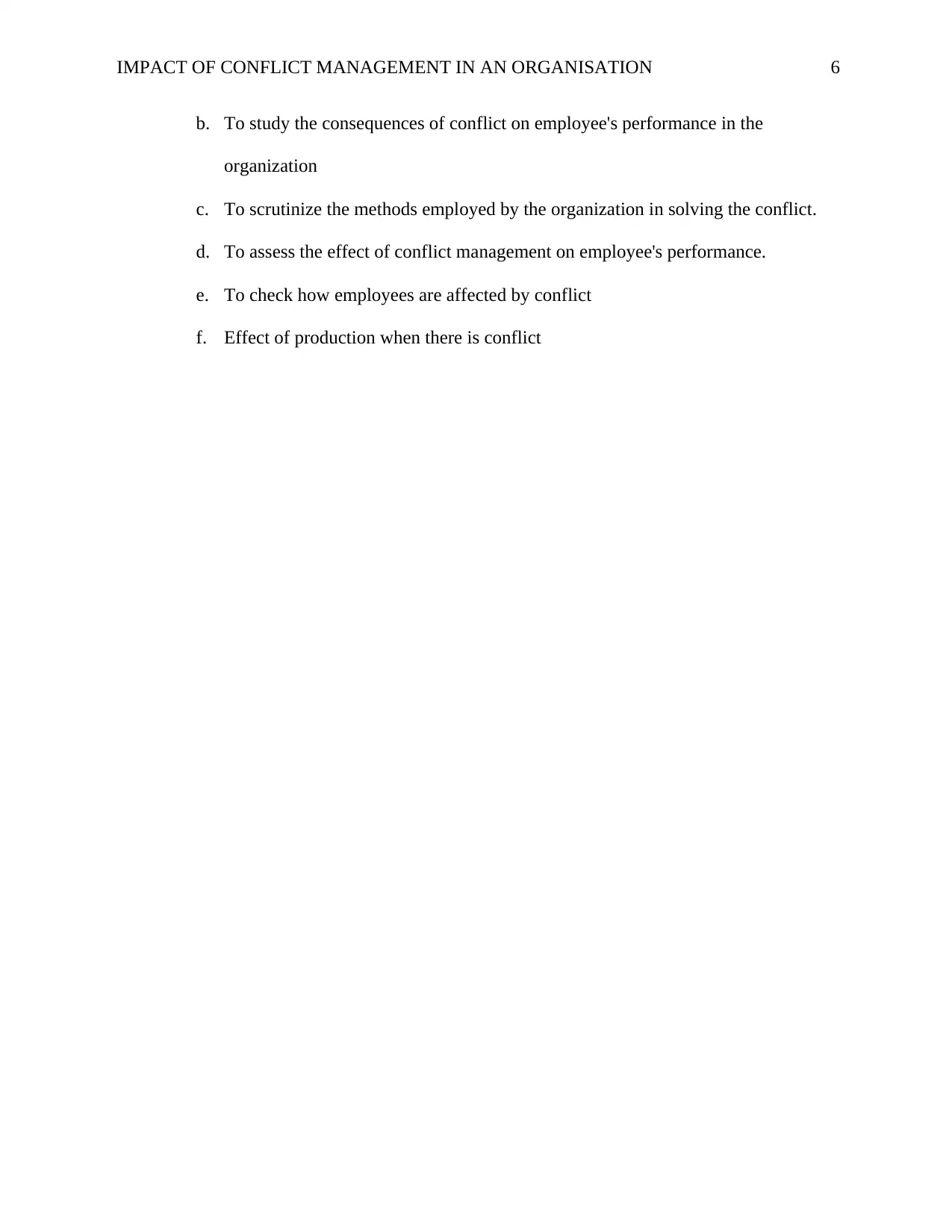
IMPACT OF CONFLICT MANAGEMENT IN AN ORGANISATION 6
b. To study the consequences of conflict on employee's performance in the
organization
c. To scrutinize the methods employed by the organization in solving the conflict.
d. To assess the effect of conflict management on employee's performance.
e. To check how employees are affected by conflict
f. Effect of production when there is conflict
b. To study the consequences of conflict on employee's performance in the
organization
c. To scrutinize the methods employed by the organization in solving the conflict.
d. To assess the effect of conflict management on employee's performance.
e. To check how employees are affected by conflict
f. Effect of production when there is conflict
⊘ This is a preview!⊘
Do you want full access?
Subscribe today to unlock all pages.

Trusted by 1+ million students worldwide
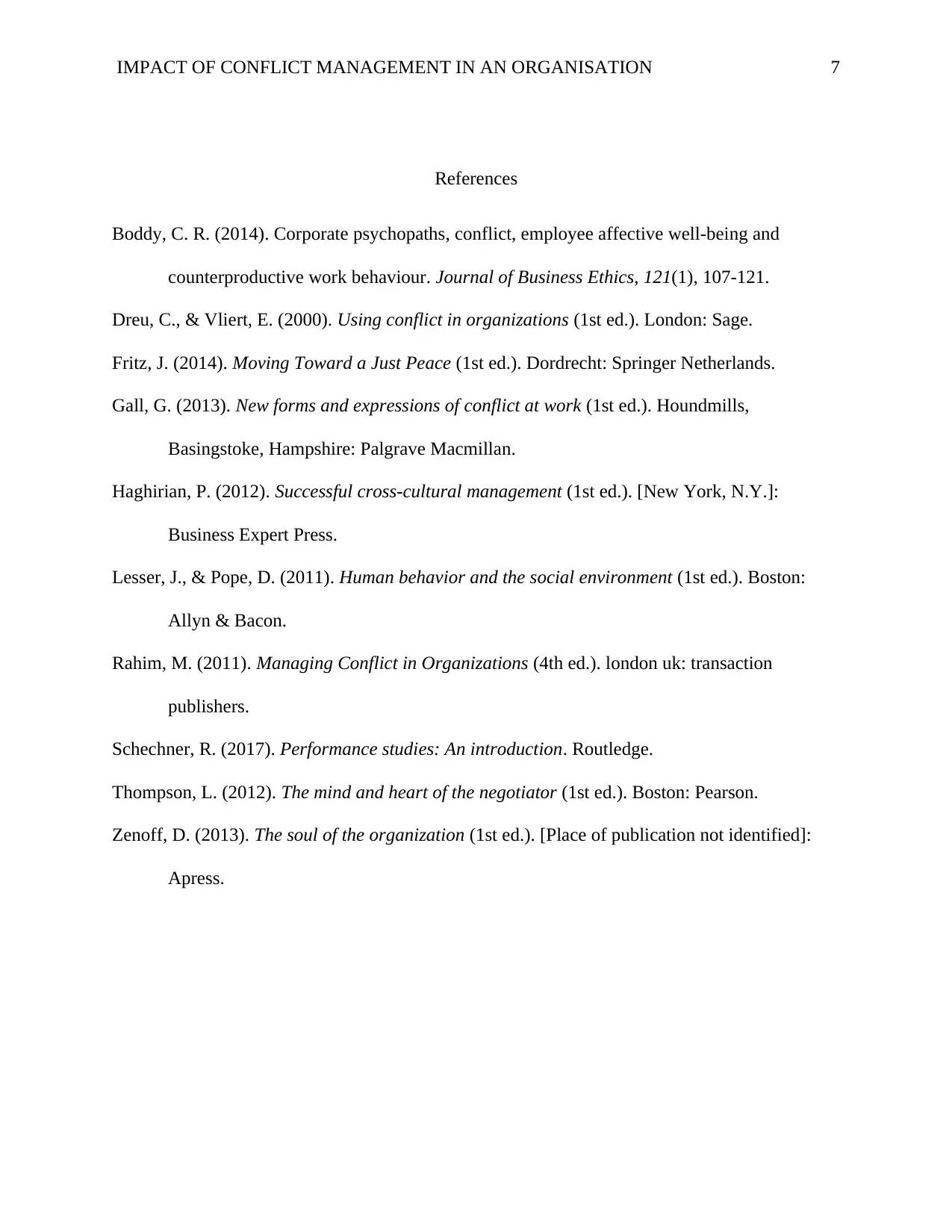
IMPACT OF CONFLICT MANAGEMENT IN AN ORGANISATION 7
References
Boddy, C. R. (2014). Corporate psychopaths, conflict, employee affective well-being and
counterproductive work behaviour. Journal of Business Ethics, 121(1), 107-121.
Dreu, C., & Vliert, E. (2000). Using conflict in organizations (1st ed.). London: Sage.
Fritz, J. (2014). Moving Toward a Just Peace (1st ed.). Dordrecht: Springer Netherlands.
Gall, G. (2013). New forms and expressions of conflict at work (1st ed.). Houndmills,
Basingstoke, Hampshire: Palgrave Macmillan.
Haghirian, P. (2012). Successful cross-cultural management (1st ed.). [New York, N.Y.]:
Business Expert Press.
Lesser, J., & Pope, D. (2011). Human behavior and the social environment (1st ed.). Boston:
Allyn & Bacon.
Rahim, M. (2011). Managing Conflict in Organizations (4th ed.). london uk: transaction
publishers.
Schechner, R. (2017). Performance studies: An introduction. Routledge.
Thompson, L. (2012). The mind and heart of the negotiator (1st ed.). Boston: Pearson.
Zenoff, D. (2013). The soul of the organization (1st ed.). [Place of publication not identified]:
Apress.
References
Boddy, C. R. (2014). Corporate psychopaths, conflict, employee affective well-being and
counterproductive work behaviour. Journal of Business Ethics, 121(1), 107-121.
Dreu, C., & Vliert, E. (2000). Using conflict in organizations (1st ed.). London: Sage.
Fritz, J. (2014). Moving Toward a Just Peace (1st ed.). Dordrecht: Springer Netherlands.
Gall, G. (2013). New forms and expressions of conflict at work (1st ed.). Houndmills,
Basingstoke, Hampshire: Palgrave Macmillan.
Haghirian, P. (2012). Successful cross-cultural management (1st ed.). [New York, N.Y.]:
Business Expert Press.
Lesser, J., & Pope, D. (2011). Human behavior and the social environment (1st ed.). Boston:
Allyn & Bacon.
Rahim, M. (2011). Managing Conflict in Organizations (4th ed.). london uk: transaction
publishers.
Schechner, R. (2017). Performance studies: An introduction. Routledge.
Thompson, L. (2012). The mind and heart of the negotiator (1st ed.). Boston: Pearson.
Zenoff, D. (2013). The soul of the organization (1st ed.). [Place of publication not identified]:
Apress.
1 out of 7
Related Documents
Your All-in-One AI-Powered Toolkit for Academic Success.
+13062052269
info@desklib.com
Available 24*7 on WhatsApp / Email
![[object Object]](/_next/static/media/star-bottom.7253800d.svg)
Unlock your academic potential
Copyright © 2020–2025 A2Z Services. All Rights Reserved. Developed and managed by ZUCOL.





